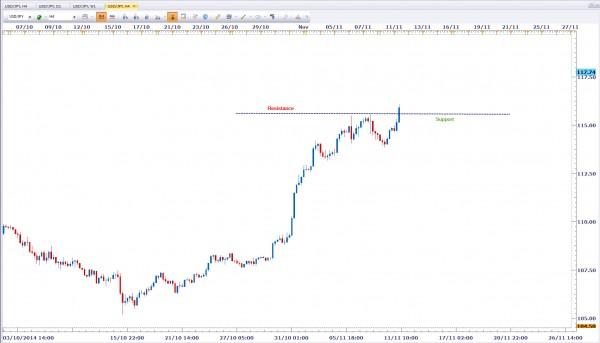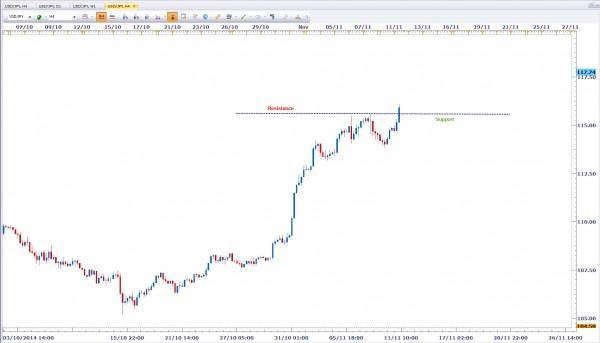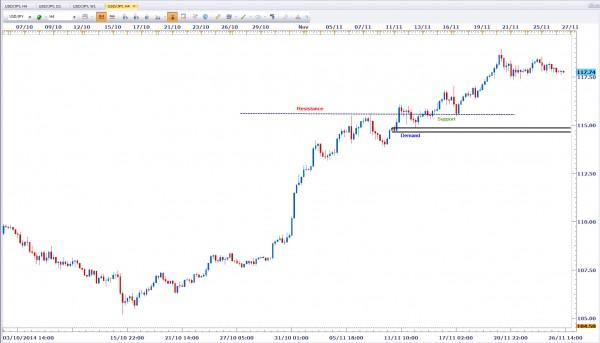![]()
I had written an article two weeks ago entitled, “The Traps of Support and Resistance,” and as promised here is part two. If you have yet to read that article you can get it right now by clicking here. In that piece we discussed the concept of what support and resistance is in relation to technical analysis and charting the currency markets. I managed to cover the four main rules, which are most commonly adopted across the universal community of trading strategies and education. These were as follows:
Buy at or near Support
Sell at or near Resistance
Old Support becomes new Resistance
Old Resistance becomes new Support
In the last article, the focus was mainly upon the dangers of implementing too many support and resistance lines on a price chart which can often lead to confusion when trying to pinpoint exactly where the best opportunity to buy or sell is on the chart. Taking this into account, the focus was placed upon the Online Trading Academy patented core strategy that recognizes objective levels of institutional demand and supply in any market and allows us to buy low or sell high using low risk and high potential reward setups. Hopefully by now you have a pretty good understanding of what a quality demand or supply looks like from what I explained in the previous content.
It is now time to move on to the third and fourth rules, as we didn’t have time to cover them last time. The concept itself is a simple one, in that technical analysis studies suggest that when areas of resistance are traded through, there follows a dynamic shift in sentiment that in turn offers us a new trading opportunity. This concept is especially applicable when trading markets that are consistently making new higher highs and new higher lows, or in the case of a downtrend, new lower lows and new lower highs. In fact it has been traditionally accepted that treating old support as new resistance or old resistance as new support, is fundamentally one of the most effective ways to engage a trend. Let’s take a look at an example below to demonstrate this principle:
In the above chart of USDJPY we can observe the continuous upwards trend and notice how the majority of the time it has been making higher highs and higher lows. Using the concept of previous resistance becoming new support, a strategy which could be considered would involve waiting for a major resistance area to be broken and then extending that line forward making the assumption that it will be tested at a later stage as a new level of support. You’ll notice that while the concept and strategy itself makes sense, the price never makes it back to test the old resistance level as support, thus leaving us missing out on the continuation of the trend. In fact if we study the above price action carefully, we notice that there have been practically no instances where any previous resistance has ever become new support. Obviously this does not mean that this event never occurs but it does also highlight that there are many times when the price will go without us, no matter how rule-based and disciplined we are. So let’s move on later in time with the same currency pair and see if there are any further opportunities where resistance has been broken and so offered us an opportunity to buy a new support. Take a look at the below example and you can see an opportunity forming:
The above chart shows us a double retest of resistance at and around the price of 115.00. Therefore taking into account that now the resistance area has been broken with a large momentum candle, we would then consider using this same line as a support area to buy if the market pulls back to it. The same price that the original resistance area was at would become the new entry price in the assumption that it must now become support. Let’s see how this would’ve worked out as a trade:
As we can see after prices did break through the resistance level, they did indeed fall back to the same area yet failed to respect the price as new support. At this stage we should ask ourselves the question of could things have been done any better? It’s incredibly difficult to place an adequate stop loss order below a single support or above a single resistance line, because the stop loss price itself is not really based on anything. There is nothing more frustrating then when you do get stopped out on a trade, only to see it then work and go in the direction you originally predicted that it would go in. This is actually what happened in the example we’re speaking about, as you’ll see from the chart example below:
According to Online Trading Academy’s educational curriculum, the situation above would be described as a trap. Do you notice how prices fell right back through the resistance level and never once regarded it as support? However, the market did go on to rally significantly from the 115.00 price area after triggering an objective level of demand, which I’ve marked out on the chart. This price action suggests to me that the institutions were relying on people using the old resistance area as a potential entry for support and so trapped most retail traders into thinking this is a good opportunity to buy, when really they themselves had their orders to buy much lower. It could even be assumed that when those people who bought at the higher price were forced to sell as their protective stop loss orders were triggered, they were in fact selling to the institutional buyers at the level of demand a little lower. This is why we think of this as a trap.
Over the years I’ve always taken a healthy interest in educating myself to the highest levels and understanding any subject I’m interested in, in the most thorough way. I also learned the hard way that education in a subject is just the first step and that we need to practically apply it so as to gain all-important experience for ourselves. One of the best ways to get that extra education and experience is to mimic those individuals who have the most success in their field, in this case financial institutions being those individuals. This is why our core strategy models the most successful investors, funds and banks and takes their outlook on the market and applies it for ourselves. Always be aware of the potential traps and pitfalls in anything you do. Knowing the environment is one thing but knowing your opponent is an altogether different dynamic in itself.
Note: All information on this page is subject to change. The use of this website constitutes acceptance of our user agreement. Please read our privacy policy and legal disclaimer. Opinions expressed at FXstreet.com are those of the individual authors and do not necessarily represent the opinion of FXstreet.com or its management. Risk Disclosure: Trading foreign exchange on margin carries a high level of risk, and may not be suitable for all investors. The high degree of leverage can work against you as well as for you. Before deciding to invest in foreign exchange you should carefully consider your investment objectives, level of experience, and risk appetite. The possibility exists that you could sustain a loss of some or all of your initial investment and therefore you should not invest money that you cannot afford to lose. You should be aware of all the risks associated with foreign exchange trading, and seek advice from an independent financial advisor if you have any doubts.
Editors’ Picks
AUD/USD rises to two-day high ahead of Aussie CPI

The Aussie Dollar recorded back-to-back positive days against the US Dollar and climbed more than 0.59% on Tuesday, as the US April S&P PMIs were weaker than expected. That spurred speculations that the Federal Reserve could put rate cuts back on the table. The AUD/USD trades at 0.6488 as Wednesday’s Asian session begins.
EUR/USD holds above 1.0700 on weaker US Dollar, upbeat Eurozone PMI

EUR/USD holds above the 1.0700 psychological barrier during the early Asian session on Wednesday. The weaker-than-expected US PMI data for April drags the Greenback lower and creates a tailwind for the pair.
Gold price cautious despite weaker US Dollar and falling US yields

Gold retreats modestly after failing to sustain gains despite fall in US Treasury yields, weaker US Dollar. XAU/USD struggles to capitalize following release of weaker-than-expected S&P Global PMIs, fueling speculation about potential Fed rate cuts.
Ethereum ETF issuers not giving up fight, expert says as Grayscale files S3 prospectus

Ethereum exchange-traded funds theme gained steam after the landmark approval of multiple BTC ETFs in January. However, the campaign for approval of this investment alternative continues, with evidence of ongoing back and forth between prospective issuers and the US SEC.
Australia CPI Preview: Inflation set to remain above target as hopes of early interest-rate cuts fade

An Australian inflation update takes the spotlight this week ahead of critical United States macroeconomic data. The Australian Bureau of Statistics will release two different inflation gauges on Wednesday.
RECOMMENDED LESSONS
Making money in forex is easy if you know how the bankers trade!
Discover how to make money in forex is easy if you know how the bankers trade!
5 Forex News Events You Need To Know
In the fast moving world of currency markets, it is extremely important for new traders to know the list of important forex news...
Top 10 Chart Patterns Every Trader Should Know
Chart patterns are one of the most effective trading tools for a trader. They are pure price-action, and form on the basis of underlying buying and...
7 Ways to Avoid Forex Scams
The forex industry is recently seeing more and more scams. Here are 7 ways to avoid losing your money in such scams: Forex scams are becoming frequent. Michael Greenberg reports on luxurious expenses, including a submarine bought from the money taken from forex traders. Here’s another report of a forex fraud. So, how can we avoid falling in such forex scams?
What Are the 10 Fatal Mistakes Traders Make
Trading is exciting. Trading is hard. Trading is extremely hard. Some say that it takes more than 10,000 hours to master. Others believe that trading is the way to quick riches. They might be both wrong. What is important to know that no matter how experienced you are, mistakes will be part of the trading process.





